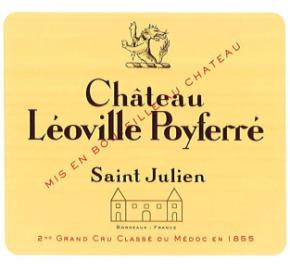Chateau Leoville Poyferre 2006
- Producer Chateau Leoville Poyferre
-
Blend
21% Merlot
6% Petit Verdot
73% Cabernet Sauvignon - Country France
- Region Bordeaux
- Appellation Saint-Julien
- UPC 0 15643 42575 2
Comments by the Chateau staff
Colour: very deep, dark colour. Brilliant.
Nose: very fresh, spicy, empyreumatic (hints of coffee)
Attack: powerful and fleshy.
Palate: plenty of freshness, beautifully fine and elegant tannins.
Really persistent and powerful, reminiscent of the great vintages to keep.
Nose: very fresh, spicy, empyreumatic (hints of coffee)
Attack: powerful and fleshy.
Palate: plenty of freshness, beautifully fine and elegant tannins.
Really persistent and powerful, reminiscent of the great vintages to keep.
Vintage 2006
After a cold, wet winter, the water levels rose, allowing a good even start of the growth cycle and an early yet short budburst for the Cabernet Sauvignon. The early heat of May lowered the water tables. The flowering was regular. The Cabernets and Petit Verdots all flowered in 4 days, a rare phenomenon. The sunshine and high temperatures of June and July (up to 41.6° C in July) augured well for high potential alcohol levels. Water was still lacking in the sub-soil, but regular showers maintained a good ripening process. The colour change occurred rapidly. The ripeness tests carried out in September again showed high levels of both potential alcohol and acidity. A week of rain and a storm on the 11th September had a diluting effect on the Merlot (which was hence present in a lesser quantity than usual in the final blend). Following this rainy period, the sun shone again throughout the harvest. More water-resistant thanks to its thicker skin, the Cabernet Sauvignon was not affected by the rain. The excellent quality of this grape variety in 2006 earnt it a preponderant place in the final blend chosen for this vintage.
From the vineyard to the cellar
Vineyard Area: 200 acres
Grape varieties: 65% Cabernet Sauvignon, 25% Merlot, 8% Petit Verdot, 2% Cabernet Franc
Soils: Garonne gravel
Vines: traditional double Guyot pruning, soil cultivation, organic fertilizer
Harvesting by hand Second sorting by hand after de-stemming Plot by plot vinification Thermo-regulated stainless steel vats 50% malolactic fermentation in barrels Ageing in French oak barrels for 18 to 20 months (75% new barrels, 25% one use)
Château Moulin Riche (product of a specific terroir) and Pavillon de Poyferré (plots of younger vines) are also produced on the estate.
Grape varieties: 65% Cabernet Sauvignon, 25% Merlot, 8% Petit Verdot, 2% Cabernet Franc
Soils: Garonne gravel
Vines: traditional double Guyot pruning, soil cultivation, organic fertilizer
Harvesting by hand Second sorting by hand after de-stemming Plot by plot vinification Thermo-regulated stainless steel vats 50% malolactic fermentation in barrels Ageing in French oak barrels for 18 to 20 months (75% new barrels, 25% one use)
Château Moulin Riche (product of a specific terroir) and Pavillon de Poyferré (plots of younger vines) are also produced on the estate.
The Chateau
Léoville is located in Saint-Julien, 45 km north-west of Bordeaux, in the heart of the Médoc region. With origins dating back to 1638; Léoville was the largest vineyard in the Médoc region at the time of the French Revolution. Léoville Poyferré springs from various divisions and successions in 1840. The outstanding quality of Léoville Poyferré wines gained early recognition when it was ranked 2nd Growth in the 1855 classification. Château Léoville Poyferré was acquired in 1920 by the Cuvelier family, wine merchants in Lille since 1804. The various divisions throughout the history of the estate have split the vineyard of Léoville Poyferré into five large areas. They include all the main types of gravelly soil present in Saint Julien: Mindel II gravel along the river banks and Mindel I type on the far end. This diversity contributes to the amplitude and complexity of the Léoville Poyferré wines. The terroir of Léoville Poyferré has been planted with vineyards producing fine wines for three centuries. Léoville Poyferré boasts a permanent observation system of the underground water tables, showing the excellent drainage conditions of the whole vineyard. This system also establishes an estimated minima for root depth. To avoid accumulation of water on the surface, we regularly decompact the soil of our plots.


